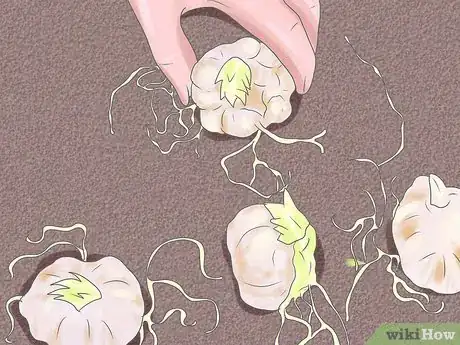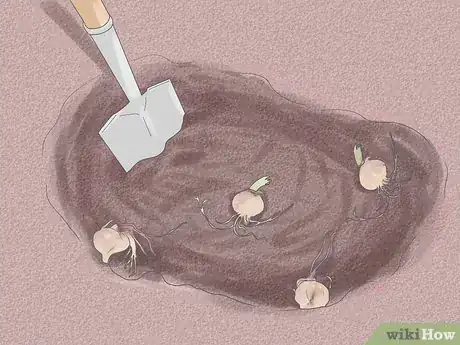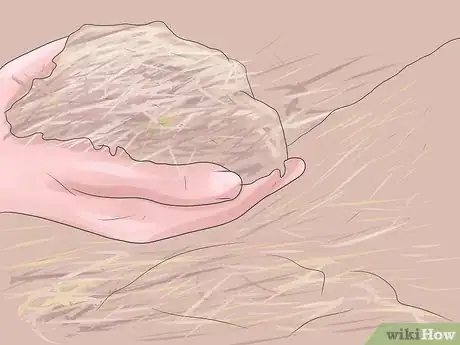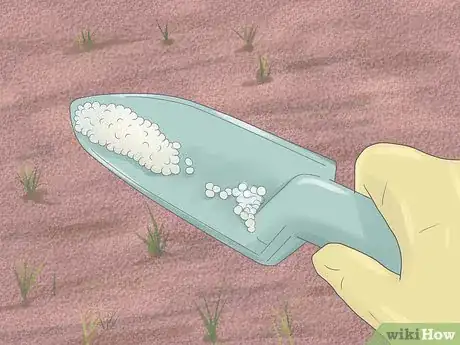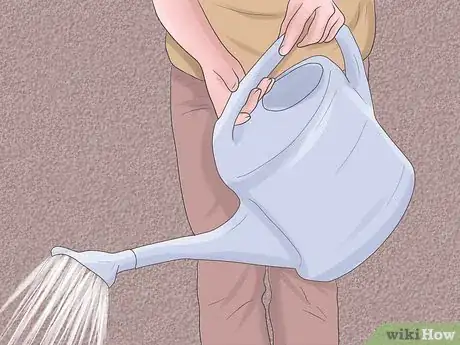This article was co-authored by Maggie Moran. Maggie Moran is a Professional Gardener in Pennsylvania.
wikiHow marks an article as reader-approved once it receives enough positive feedback. In this case, 84% of readers who voted found the article helpful, earning it our reader-approved status.
This article has been viewed 429,895 times.
Lilies are beautiful flowers with lovely aromas, loved by gardeners, florists, and anybody who appreciates fragrance and beauty. Lilies are remarkably hardy, easy to grow, and easy to maintain. This article will show you how to plant them, and how to keep them thriving for many years to come.
Steps
Planting Lilies
-
1Find the right location. Ideally, pick a spot in your garden with good drainage and plenty of sunlight. Lilies need a well-drained planting medium, such as sand or other porous soil.
- To find a good drainage location, find the spot in your garden that dries out the quickest after a pour of rain. If there is no obvious location, plant your lilies on a slope, and let gravity take care of your drainage.
- Find a spot that gets sunshine at least half the day. Too long in the shade, and the lilies will reach for the sun, and take on a noticeable lean. A full day's sun is ideal.
- Lily leaves can be infested with fungal botrytis if the planting location is less than ideal. While botrytis is great for certain types of wine grapes, it reduces the leaf area used for manufacturing the sugars that will result in healthy new bulbs.
-
2Plant the bulbs when you get them. Lily bulbs come ready to plant, and lack a papery covering known as a "tunic" that keeps bulbs from drying out.[1]
- The sooner you plant your bulbs after receiving them, the better they will perform. If you cannot plant them immediately, keep them in a cold, dark place (such as your refrigerator—as long as it's kept above freezing). Do this to keep them from sprouting, for once they do, you'll need to plant them.
- Plant them in the fall or early winter to have them bloom in the spring. You can also plant them in the spring, and they will bloom later in the year. The will bloom "normally" the following spring.
Advertisement -
3Dig a hole. Lilies like the sun, but their bulbs prefer to stay cool during the summer. Digging a hole about 12 to 15 inches (30 to 38cm) deep, and keep in mind that deeper is better—not only will the bulbs be protected from potentially hot summers, it will also provide good support for the stems. Your holes should be 2 to 3 times as deep as the bulb itself. Plant the bulb with the pointed side up.
- You can also plant them in a raised bed: plant them at ground level, then put 4 to 6 inches (10 to 15cm) of soil on top of them. This will also promotes good drainage.
- Space them properly. If you're planting multiple lilies, give each lily about a 6-inch radius so that they have their own place in the sun.
- Loosen the dirt at the bottom of the hole, sprinkle a little bone meal into the bottom, then place the lily bulbs inside and cover with dirt.
- Water immediately. This will ensure that damp soil comes in contact with the roots, encouraging growth.
-
4Add mulch. Lilies appreciate it if you add some organic material to help keep the surrounding soil cool and moist. Spread compost, rotted manure, or a longer-lasting mulch like bark mulch, wood ships, or cacao shells around the plant.[2] If you're expecting cold weather, lay a top coating of mulch over the plantings to protect the shoots.
- Trumpet lilies are the most vulnerable to frost damage.
- Make sure you keep your mulch slug-free! They would love to munch on your emerging lily shoots.
Caring for Your Lilies
-
1Fertilize your lilies. When they first push up shoots, add a little well-balanced fertilizer. Lilies are fairly hardy, and don't require a lot of fertilizer. In fact, too much nitrogen can result in weak stems, and in hot, wet climates can also result in bulb rot.
- For optimal results, choose a high-potassium liquid fertilizer. Apply this every two weeks from early spring until 6 weeks after the plant flowers.[3]
- Fertilize when first sprouting, and again about a month later.
-
2Water your lilies only as needed. Lilies generally don't need a lot of water, so only water if required.
- Asiatic lilies, Trumpets, and Orienpets flourish in hot, dry climates, as long as they have enough water up to flowering time.
- Orientals need watering during the summer, as they do not blossom until August.
- Adding mulch in the summer helps keep the bulbs cool, and so lowers the need for additional watering.
-
3Protect from freezing. During winter months, cover the lily bed with straw or evergreen boughs to protect the bulbs from freezing.
-
4Keep the lilies trimmed. During the flowering season, trim the spent blooms, keeping at least 2/3s of the stem intact to keep your strong and healthy for years to come.[4]
Expert Q&A
Did you know you can get expert answers for this article?
Unlock expert answers by supporting wikiHow
-
QuestionDo I need to deadhead my lilies?
 Lauren KurtzLauren Kurtz is a Naturalist and Horticultural Specialist. Lauren has worked for Aurora, Colorado managing the Water-Wise Garden at Aurora Municipal Center for the Water Conservation Department. She earned a BA in Environmental and Sustainability Studies from Western Michigan University in 2014.
Lauren KurtzLauren Kurtz is a Naturalist and Horticultural Specialist. Lauren has worked for Aurora, Colorado managing the Water-Wise Garden at Aurora Municipal Center for the Water Conservation Department. She earned a BA in Environmental and Sustainability Studies from Western Michigan University in 2014.
Professional Gardener
-
QuestionDo lilies need lots of sun?
 Lauren KurtzLauren Kurtz is a Naturalist and Horticultural Specialist. Lauren has worked for Aurora, Colorado managing the Water-Wise Garden at Aurora Municipal Center for the Water Conservation Department. She earned a BA in Environmental and Sustainability Studies from Western Michigan University in 2014.
Lauren KurtzLauren Kurtz is a Naturalist and Horticultural Specialist. Lauren has worked for Aurora, Colorado managing the Water-Wise Garden at Aurora Municipal Center for the Water Conservation Department. She earned a BA in Environmental and Sustainability Studies from Western Michigan University in 2014.
Professional Gardener
-
QuestionCan you cut down lilies after they bloom?
 Lauren KurtzLauren Kurtz is a Naturalist and Horticultural Specialist. Lauren has worked for Aurora, Colorado managing the Water-Wise Garden at Aurora Municipal Center for the Water Conservation Department. She earned a BA in Environmental and Sustainability Studies from Western Michigan University in 2014.
Lauren KurtzLauren Kurtz is a Naturalist and Horticultural Specialist. Lauren has worked for Aurora, Colorado managing the Water-Wise Garden at Aurora Municipal Center for the Water Conservation Department. She earned a BA in Environmental and Sustainability Studies from Western Michigan University in 2014.
Professional Gardener
Warnings
- Inspect your young stems for garden grubs regularly when the plants are still growing. The nutrient-packed shoots are delicacies for grubs, and if attacked, they will die before they can produce flowers.⧼thumbs_response⧽
Things You'll Need
- Lily bulbs
- Garden shovel
- Mulch (for colder climates)
- Fertilizer
- Potting soil (optional)
References
- ↑ http://www.gardeners.com/Growing-Lilies/5326,default,pg.html
- ↑ http://www.gardeners.com/how-to/growing-lilies/5326.html
- ↑ https://www.almanac.com/plant/lilies
- ↑ https://www.gardendesign.com/flowers/lilies.html
- ↑ https://www.gardendesign.com/flowers/lilies.html
- http://www.gardeners.com/Growing-Lilies/5326,default,pg.html
About This Article
To care for lilies, keep them in a spot that gets sunshine for at least half of the day so they don't get leggy. Also, only water your lilies when they need it since lilies don't require a lot of water. You can also apply a high-potassium liquid fertilizer every 2 weeks from early spring to 6 weeks after the lilies flower. During the flowering season, cut back any dead blooms, and leave two-thirds of the stems intact when you cut them. For more advice from our Horticulture co-author, like how to plant lilies, read on!

